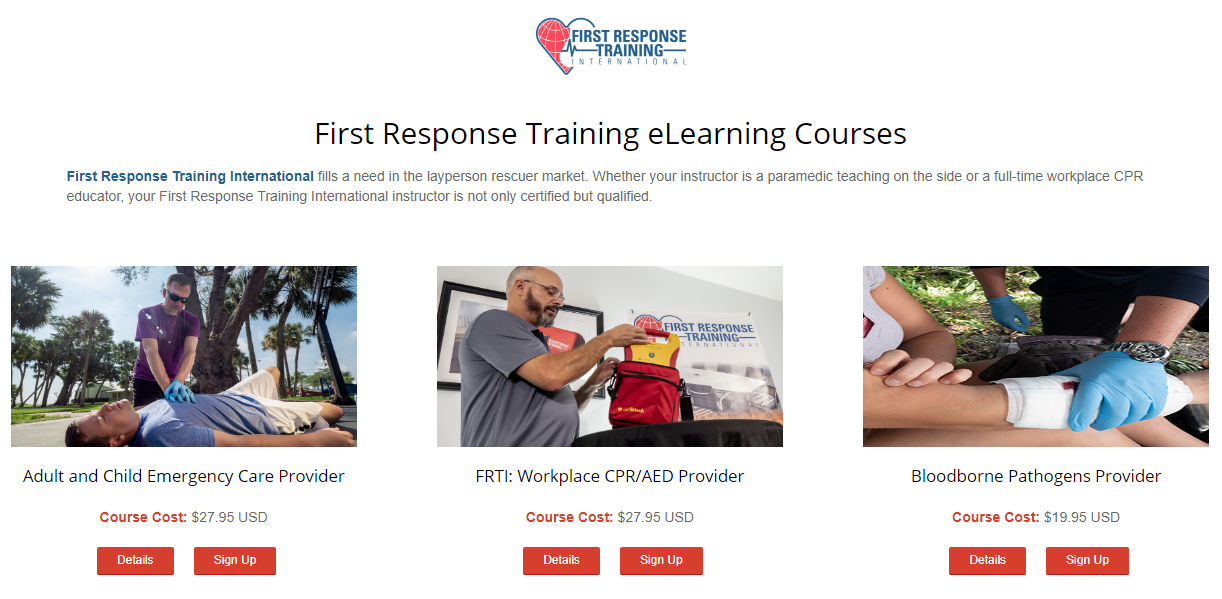What Does a First Aid Course Involve?
By: Dillon Waters
Taking a First Response Training International First Aid course could end up being one of the most important things you ever do. You will have the knowledge, skills, and confidence to act and potentially deliver life-saving care if you are confronted with an emergency situation. Although those situations aren’t common for the majority, this training will also be invaluable for everyday situations that you may encounter while at work, home, or school.
As this course is designed to accommodate individuals without any prior knowledge, there is no reason to be worried about not being prepared. Your First Response Training International instructor understands this may be your first experience with a life-saving or first aid course and will be there to assist you or answer any questions that you may have during your class. To ease your mind though, we will be completely transparent and include a breakdown of what you can expect from a First Response Training International first aid course below:
Knowledge Training
The knowledge portion of the course will be split into two sections; eLearning and in-class instruction. With this combined method of instruction, you can expect to learn and retain more information easier than ever before. As you go through the eLearning, you will be introduced to the theory and principles of first aid situations that require a response, as well as the laws surrounding your response to the situation. Once you are in the classroom with the instructor, you will take the knowledge learned and apply that to real-world situations. You can expect to learn:
- What is first aid?
- Cardiopulmonary Resuscitation (CPR)
- When to perform CPR
- Compressions and ventilations
- Personal protection equipment
- Performing CPR
- Scene assessment
- Emergency medical services activation
- Compressions, airway, breathing (CAB)
- Compression protocol
- Ventilation protocol
- Team CPR
- Define First Aid
- Personal protection equipment (PPE)
- When and how must first aid be administered
- Injury and scene assessment
- Assess for “The Six Basics”
- Breathing (absent) = CPR
- Bleeding = Pressure
- Broken = Immobilize
- Burns = Cool
- Bites = Cover
- Blows = Watch
- Choking
- Level of airway obstruction
- Treatment methods
- Special considerations for children
- Automated External Defibrillator (AED)*
- When to use
- How to use
- Infant/child
- Adult
- AED maintenance and storage
- Rules and regulations regarding AEDs
- Neurological
- Administering field test
- Keeping notes of results
- Repeating test
- Administering field test
- Post Trauma Considerations for Lay Rescuers
Skills Training
The skills portion of the course will be introduced in the classroom by a First Response Training International instructor. This section of the course will be primarily “hands on” and is intended to teach you the proper way to respond and administer first aid techniques. Your instructor will work with you individually on the practical application of the skills and relate them to real-life scenarios that you may encounter. This portion of the course is invaluable and is required along with the knowledge for certification. The skills you can expect to practice are:
- Scene entry and assessment
- Perform single person CPR on a manikin – infant and adult
- CABs
- First aid; treat a simulated injury for each of “The Six Basics”
- Breathing (absent) = CPR
- Blows = Watch
- Bites = Cover
- Burns = Cool
- Broken = Immobilize
- Bleeding = Pressure
- Deploy AED and follow prompts for use
Once you complete your First Response Training International course, you will have the knowledge, skills, and confidence to respond to an emergency situation. The knowledge you learn in your course will be applicable to your daily life and is an invaluable step in ensuring you are prepared for situations that you will encounter. Whether this is your first time taking a course in first aid, or you are a course veteran, you can relax knowing this course will fit your needs as a student ensuring you learn the most knowledge in the most efficient way.
















Lascia un Commento
Vuoi partecipare alla discussione?Sentitevi liberi di contribuire!